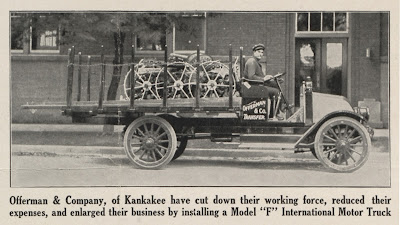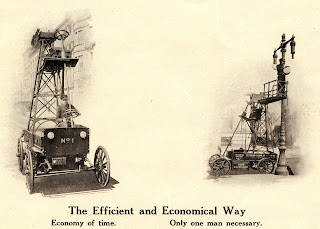Since the beginning of the automotive age, there has been almost no end to the specialization found among commercial vehicles. The business community quickly sought to utilize and profit from the new horseless carriage, yet it took a while for them to truly find their wheels and begin to realize the potential benefits to be derived from the combustion engine. Each subsequent advance in the automotive industry was explored for commercial applications as well. The library stacks at Hagley are filled with examples reminding readers that innovations in commercial vehicles, such as those demonstrated below, have never really gone out of style.

Competing against the horse was the easy part. A mailer from the International Harvester Company from 1917 summarily points out the advantages of motor-power: Horses have to eat. Horses have to sleep. Horses die and must be replaced. The International Motor truck, on the other hand, is cheaper to maintain and can run faster and longer (no mention is made of planned obsolescence). Profits will go up and expenses will go down. A business can thus expand with the savings acquired from abandoning horse-drawn vehicles and purchasing the International Motor truck.

Convincing automotive converts that your commercial vehicle is superior to others on the market turned out to be a bigger challenge -- and a bigger opportunity. The International Motor Company touted the extraordinary strength and versatility of its Mack and Saurer trucks in a pamphlet entitled Proving Truck Quality..., ca.1920. Among many examples offered are a 5-ton Saurer truck shown carrying a 50-foot steel girder and a 5-ton Mack truck hauling a 16,000-lb. locomotive (shown on right). This type of promotion was already a common method of drawing attention to one’s product. Alternatively, the Commercial Truck Company of America produced an undated pamphlet (circa 1920s), with a priceless title: If You Are a Big Man with a Receptive Mind, Look This Over; If Not Give It to a Subordinate Who is After Your Job. In this publication, the company touted the innovative design of its Lamp Trimmer’s Wagon, an electric vehicle custom designed and built to meet the needs of the Philadelphia Electric Company. This early utility truck allowed one man to perform work normally accomplished by two people using a horse or motorcycle and wagon. The trick was that the Lamp Trimmer’s Wagon could be operated from the driver’s seat or the upper platform. Although specialized for a niche market, this pamphlet serves the purpose of advertising both the vehicle in question, and the ability of the company in general, to customize vehicles, design solutions, and collaborate with other potential clients.
 Yet another innovation was the mobile home, a uniquely American invention that began to gain traction in the late 1920s. Based upon early camping trailers, the mobile home had all the benefits one’s immobile home did not. People lived in them, vacationed in them, and businesses sought to adapt them as commercial vehicles. In an advertisement entitled "Ride Through Sales Resistance," the Curtiss Aerocar Company promoted the many virtues of the new Curtiss Aerocar. Unlike earlier commercial vehicles designed simply to haul or lift, the Aerocar was promoted as a mobile showroom, where finished products were driven directly to consumer markets. The Fostoria Glass Company, Norge, and Victor Radio are just some of the businesses that employed Curtiss Aerocars as part of their sales strategies. This was a novel approach that aimed to move businesses beyond the inherent limitations of franchise locations and mail-order catalogs.
Yet another innovation was the mobile home, a uniquely American invention that began to gain traction in the late 1920s. Based upon early camping trailers, the mobile home had all the benefits one’s immobile home did not. People lived in them, vacationed in them, and businesses sought to adapt them as commercial vehicles. In an advertisement entitled "Ride Through Sales Resistance," the Curtiss Aerocar Company promoted the many virtues of the new Curtiss Aerocar. Unlike earlier commercial vehicles designed simply to haul or lift, the Aerocar was promoted as a mobile showroom, where finished products were driven directly to consumer markets. The Fostoria Glass Company, Norge, and Victor Radio are just some of the businesses that employed Curtiss Aerocars as part of their sales strategies. This was a novel approach that aimed to move businesses beyond the inherent limitations of franchise locations and mail-order catalogs.
 It is easy to think of the past as an idyllic and simpler time; however, innovations in every field of business were constantly sought after in the relentless pursuit of profits. Even today the evolution of commercial vehicles continues to play a part in this ongoing history.
It is easy to think of the past as an idyllic and simpler time; however, innovations in every field of business were constantly sought after in the relentless pursuit of profits. Even today the evolution of commercial vehicles continues to play a part in this ongoing history.
For additional information about the items mentioned here or to set up an appointment at the Hagley Library, please contact Max Moeller, Head of Imprints, at 302-658-2400 x226 or send email inquiries to research@hagley.org.
Sources:
Commercial Truck Company of America. If you are a big man with a receptive mind, look this over ; if not give it to a subordinate who is after your job. 192-? Hagley Trade Catalogs and Pamphlet Collection, Pam 2003.603. View item in Hagley Digital Archives
Curtiss Aerocar Company, Inc. “Ride Through Sales Resistance” in Fortune, March 1934. Hagley Imprints, HF5001 F75
International Harvester Company of America. Horse-power versus motor-power. 1917. Pam (I). View item in Hagley Digital Archives
International Motor Company. Proving truck quality... ca. 1920. Trade Cat. View item in Hagley Digital Archives
For more information about the Hagley Library, please visit www.hagley.org/library
